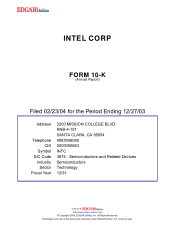Intel 2003 Annual Report Download - page 10
Download and view the complete annual report
Please find page 10 of the 2003 Intel annual report below. You can navigate through the pages in the report by either clicking on the pages listed below, or by using the keyword search tool below to find specific information within the annual report.
Table of Contents
Index to Financial Statements
point-of-sale systems and monitoring equipment, as well as other applications. Our product families include the Celeron and Intel
®
Pentium
®
III processors, as well as the Mobile Intel Pentium 4 Processor-M and the Intel Pentium 4 processor. We also offer Intel Xeon processors with
HT Technology, providing increased performance for wireless infrastructure equipment. In April 2003, we added the Intel Pentium M
processor for embedded communications applications, which brings higher performance and better power management to ultra-dense modular
communications equipment. It is used to manage network processors, line cards and other components in equipment such as radio network
controllers and media gateway controllers.
In June 2003, we announced that we will support Advanced Switching, a standards-based extension of the PCI Express technology
designed for the computing industry. Advanced Switching builds on the PCI Express technology to provide advanced communications features
for interconnecting components and system boards in communications, storage and embedded applications. Having a widely accepted modular
specification for interconnect technology is expected to lower development costs, increase reusability of technology and reduce time-to-market
of new products. In September 2003, we demonstrated our first chips based on PCI Express technology and detailed our plans for integrating
the next-generation interconnect of this technology into forthcoming computing and communications products in 2004.
In October 2003, we announced a new suite of Intel
®
NetStructure
™
communications building blocks based on the Advanced Telecom
Computing Architecture (an architecture for building standards-based wireless base station equipment) and featuring Intel microprocessors and
network processors. The new products are designed to deliver high performance and high availability in carrier-grade wireless and wired
telecommunications infrastructure applications.
In March 2003, we introduced the Intel
®
TXN18107 10-
Gpbs XFP Transceiver, an optical transceiver that operates at multiple data rates,
enabling equipment manufacturers to qualify a single part for multiple applications.
Microcontrollers
Our microcontrollers are primarily used in automotive systems. Product families include the Intel
®
186, Intel386
™
, Intel486
™
and Intel
®
i960
®
processors; and 8-bit and 16-bit microcontrollers.
Wireless Communications and Computing Group
WCCG provides component-level building blocks for digital cellular communications and other applications requiring both low-power
processing and high performance. For the handheld platform, including cellular phones and personal digital assistants (PDAs), our current
products include flash memory, application and cellular processors based on the Intel XScale microarchitecture, and cellular baseband chipsets.
In addition, our Intel
®
Personal Internet Client Architecture (Intel
®
PCA) outlines an architecture for communications, application and memory
subsystems for data-enabled mobile phones, and portable handheld devices. Growth in the market segment for handheld computing and
communications devices is dependent upon the increased use of devices with more data-intensive applications and additional capabilities.
Net revenue for WCCG made up approximately 6% of our consolidated net revenue for 2003.
Flash Memory
Flash memory is a specialized type of memory component used to store user data and program code; it retains this information even when
the power is off. Flash memory is based on either NOR or NAND architectures. Our flash memory is based on the NOR architecture. NOR
flash memory, with its fast “read” capabilities, has traditionally been used to store executable code. NAND flash memory, which is slower in
reading data but faster in writing data, has traditionally been used in products that either required large storage capacity or fast write
applications, such as MP3 music players, memory cards and digital cameras. Although our NOR flash memory is currently used predominantly
in mobile phones and PDAs, it is also found in other consumer products, including set-top boxes and MP3 players.
In April 2003, we introduced the Intel
®
Ultra-Thin Stacked Chip-Scale Packaging, featuring 1.8-volt Intel StrataFlash
®
wireless memory.
This product allows up to five ultra-thin memory chips to be stacked in one package, delivering greater memory capacity and lower power
consumption in a smaller package. With heights as low as 1.0mm, this new package allows manufacturers to increase memory density and
provide features such as camera capabilities, games and e-mail in relatively thin cell phones. Intel StrataFlash wireless memory technology
allows 2 bits of data to be stored in each memory cell, for higher storage capacity and lower cost.
7























